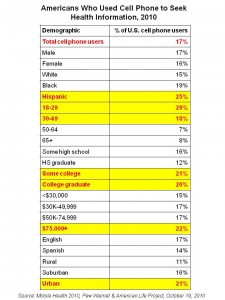The oracle (and I use the word here in the classic sense) of health internet statistics, Susannah Fox (@susannahfox on Twitter), along with the Pew Internet & American Life Project and the California HealthCare Foundation, find that 17% of mobile phone users look up health information online — and nearly 1 in 3 young adults 18-29 do so, while between 5-6% of people 50 and seek health information via mobile. The Mobile Health 2010 report tells the story.
Beneath these macro statistics are the ones shown in the chart: people who have used cell phones to look up health information, which is a larger base of 17% of cell phone users. There’s more traction here, given that more people — about twice as many — access the internet via mobile phones than use health apps. The largest cohorts of American adults using mobile phones to search health information are Hispanic people, people under 50 years of age, Americans with some college or grads, the wealthy (with annual incomes over $75K) and urban folk.
There’s a big number that’s a key to this dataset: 78% of mobile users have looked online for health information. Fox points out that the mobile platform makes a difference in peoples’ information-seeking behavior on the internet: people with wireless access are more likely to use the internet to gather, share and create new content. This is translating over to health information gathering, sharing and creating, as well.
The survey also looked at peoples’ use of mobile phone apps for health. The most outstanding, statistically significant finding from this question is that 15% of Black Americans use mobile health apps: this percentage matches that of people age 18-29 (the youngest age cohort polled) using cell phone health apps. Other statistically significant demographic cohorts using mobile health apps are that 13% of people with ‘some college’ and 12% of cell phone users in urban areas.
Pew conducted this survey in August and September 2010 among 3,001 adults age 18 and over.
Health Populi’s Hot Points: The statistically significant findings in the Pew mobile health survey have strategic implications. Hispanic and Black people tend to use mobile-health more than White people for both overall health information search as well as mobile health apps. Given the reality of health disparities in the U.S. between White vs. Hispanic and Black health citizens, the mobile phone can become a useful strategic ally in addressing this issue that’s long-plagued the American health system. Text4Baby, for example, is seeking to ameliorate challenges of prenatal care for minorities and people who haven’t effectively accessed OB services. Health disparities such as primary care access for children with asthma in urban centers, heart disease prevalence among African-American women, and diabetes epidemic for Hispanic people can provide important use-cases on which to build evidence on the efficacy of texting for health and using mobile health apps.
Increasingly, the mobile phone will be used for public health by private citizens. The Pew data lays the foundation for us to begin to target populations and take advantage — in the best sense — of peoples’ communication platform choices where and how they live.





 Interviewed live on BNN Bloomberg (Canada) on the market for GLP-1 drugs for weight loss and their impact on both the health care system and consumer goods and services -- notably, food, nutrition, retail health, gyms, and other sectors.
Interviewed live on BNN Bloomberg (Canada) on the market for GLP-1 drugs for weight loss and their impact on both the health care system and consumer goods and services -- notably, food, nutrition, retail health, gyms, and other sectors. Thank you, Feedspot, for
Thank you, Feedspot, for  As you may know, I have been splitting work- and living-time between the U.S. and the E.U., most recently living in and working from Brussels. In the month of September 2024, I'll be splitting time between London and other parts of the U.K., and Italy where I'll be working with clients on consumer health, self-care and home care focused on food-as-medicine, digital health, business and scenario planning for the future...
As you may know, I have been splitting work- and living-time between the U.S. and the E.U., most recently living in and working from Brussels. In the month of September 2024, I'll be splitting time between London and other parts of the U.K., and Italy where I'll be working with clients on consumer health, self-care and home care focused on food-as-medicine, digital health, business and scenario planning for the future...